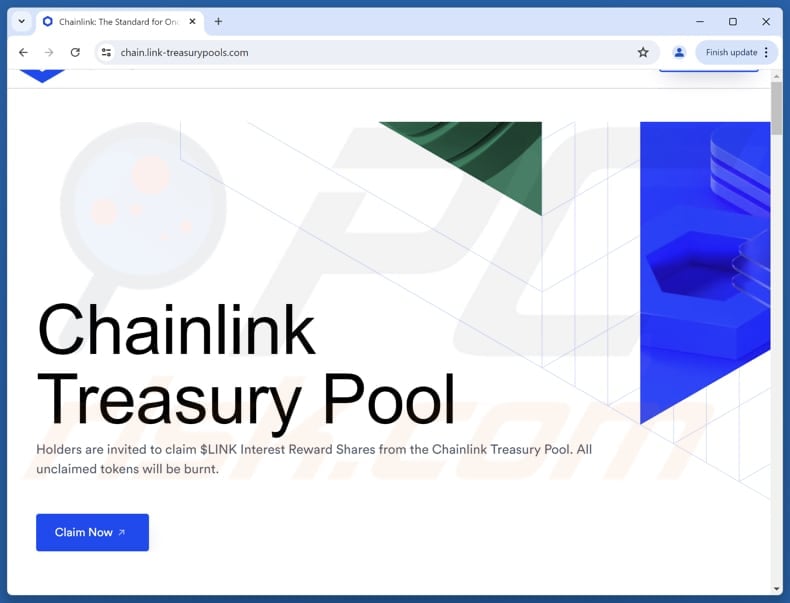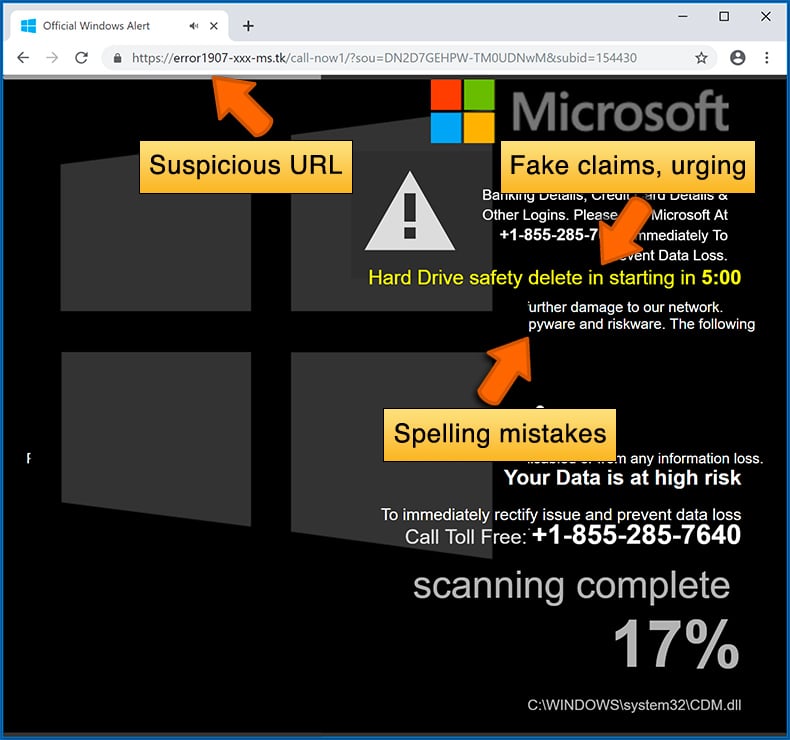How to recognize fake sites like "Chainlink Treasury Pool"
Phishing/ScamAlso Known As: Fake Chainlink Treasury Pool
Get free scan and check if your device is infected.
Remove it nowTo use full-featured product, you have to purchase a license for Combo Cleaner. Seven days free trial available. Combo Cleaner is owned and operated by RCS LT, the parent company of PCRisk.com.
What is "Chainlink Treasury Pool" scam?
We have examined this website (chain.link-treasurypools[.]com) and found that it is a fraudulent website offering to claim free tokens. Also, the site mimics the original Chainlink platform (chain.link) to appear legitimate. The purpose of the fake page is to drain victims' wallets.

IMPORTANT NOTE: We do not review crypto projects, please do your own research when investing money.
Federal Trade Commission (FTC) states that since the start of 2021, more than 46,000 people have reported losing over $1 billion in crypto to scams – that's about one out of every four dollars reported lost, more than any other payment method.
"Chainlink Treasury Pool" scam in detail
Chainlink (chain.link) is a blockchain platform that connects smart contracts to real-world information. It uses decentralized oracles to provide accurate and reliable data. LINK ($LINK) is the cryptocurrency used to pay for these services. This lets smart contracts interact with external data safely and automatically.
The deceptive website (chain.link-treasurypools[.]com) states that holders are invited to claim $LINK Interest Reward Shares from the Chainlink Treasury Pool. It also encourages visitors to act quickly by mentioning that all unclaimed tokens will be burnt. Its goal is to trick visitors into connecting their wallets.
If visitors connect their wallets, the page activates a cryptocurrency drainer. This tool can steal funds by moving cryptocurrency from connected wallets to addresses controlled by cybercriminals. Since blockchain transactions cannot be reversed, victims generally cannot recover stolen crypto.
In short, linking a wallet through this fraudulent site can lead to permanent financial loss. Therefore, users should always carefully check websites, especially those promising rewards, to avoid scams.
| Name | Fake Chainlink Treasury Pool |
| Threat Type | Scam, Social Engineering, Fraud |
| Fake Claim | Visitors can claim $LINK tokens |
| Disguise | Legitimate Chainlink website |
| Related Domain | chain.link-treasurypools[.]com |
| Detection Names () | Emsisoft (Phishing), Fortinet (Phishing), Netcraft (Malicious), Seclookup (Malicious), Webroot (Malicious), Full List Of Detections (VirusTotal) |
| Symptoms | Unofficial domain, lack of official verification, unrealistic claims, too good-to-be-true promises |
| Distribution methods | Fake social media accounts, deceptive websites, rogue online advertisements |
| Damage | Cryptocurrency theft |
| Malware Removal (Windows) |
To eliminate possible malware infections, scan your computer with legitimate antivirus software. Our security researchers recommend using Combo Cleaner. Download Combo CleanerTo use full-featured product, you have to purchase a license for Combo Cleaner. 7 days free trial available. Combo Cleaner is owned and operated by RCS LT, the parent company of PCRisk.com. |
Conclusion
In conclusion, users should be very cautious with websites claiming to offer free cryptocurrency. Connecting a wallet while on chain.link-treasurypools[.]com can result in irreversible financial loss, so it is essential to verify the legitimacy of sites before interacting with them.
Some examples of similar scams are "Ethena ($ENA) Treasury Pool Scam", "Fidelity Solana Airdrop Scam", and "Ether.fi Treasury Pool Scam".
How did I open a scam website?
Crypto scams and fraudulent sites are commonly promoted through compromised WordPress pages and fake or stolen social media accounts on platforms like Facebook and Twitter/X. Scammers also use malicious emails, adware, and pages that use unreliable ad networks (often found on illegal streaming sites, adult sites, torrent pages, and similar platforms).
Additionally, users can encounter scam pages after clicking on deceptive notifications from untrustworthy websites, as well as ads, buttons, links, or other misleading elements on risky websites.
How to avoid visiting scam pages?
Be cautious with any unexpected emails or messages, especially if they urge you to open attachments/files or click links. If a suspicious website requests notification permissions, do not accept its notifications. Only download software from trusted sources, such as official app stores or the developer's website.
Do not interact with pop-ups, ads, and other content on questionable websites. Keep your operating system and apps up to date, and run regular scans with reputable antivirus software. If your computer is already infected with unwanted apps, we recommend running a scan with Combo Cleaner Antivirus for Windows to automatically eliminate them.
The appearance of "Chainlink Treasury Pool" scam (GIF):

The original Chainlink website (chain.link):

Instant automatic malware removal:
Manual threat removal might be a lengthy and complicated process that requires advanced IT skills. Combo Cleaner is a professional automatic malware removal tool that is recommended to get rid of malware. Download it by clicking the button below:
DOWNLOAD Combo CleanerBy downloading any software listed on this website you agree to our Privacy Policy and Terms of Use. To use full-featured product, you have to purchase a license for Combo Cleaner. 7 days free trial available. Combo Cleaner is owned and operated by RCS LT, the parent company of PCRisk.com.
Quick menu:
- What is Fake Chainlink Treasury Pool?
- How to identify a pop-up scam?
- How do pop-up scams work?
- How to remove fake pop-ups?
- How to prevent fake pop-ups?
- What to do if you fell for a pop-up scam?
How to identify a pop-up scam?
Pop-up windows with various fake messages are a common type of lures cybercriminals use. They collect sensitive personal data, trick Internet users into calling fake tech support numbers, subscribe to useless online services, invest in shady cryptocurrency schemes, etc.
While in the majority of cases these pop-ups don't infect users' devices with malware, they can cause direct monetary loss or could result in identity theft.
Cybercriminals strive to create their rogue pop-up windows to look trustworthy, however, scams typically have the following characteristics:
- Spelling mistakes and non-professional images - Closely inspect the information displayed in a pop-up. Spelling mistakes and unprofessional images could be a sign of a scam.
- Sense of urgency - Countdown timer with a couple of minutes on it, asking you to enter your personal information or subscribe to some online service.
- Statements that you won something - If you haven't participated in a lottery, online competition, etc., and you see a pop-up window stating that you won.
- Computer or mobile device scan - A pop-up window that scans your device and informs of detected issues - is undoubtedly a scam; webpages cannot perform such actions.
- Exclusivity - Pop-up windows stating that only you are given secret access to a financial scheme that can quickly make you rich.
Example of a pop-up scam:

How do pop-up scams work?
Cybercriminals and deceptive marketers usually use various advertising networks, search engine poisoning techniques, and shady websites to generate traffic to their pop-ups. Users land on their online lures after clicking on fake download buttons, using a torrent website, or simply clicking on an Internet search engine result.
Based on users' location and device information, they are presented with a scam pop-up. Lures presented in such pop-ups range from get-rich-quick schemes to fake virus scans.
How to remove fake pop-ups?
In most cases, pop-up scams do not infect users' devices with malware. If you encountered a scam pop-up, simply closing it should be enough. In some cases scam, pop-ups may be hard to close; in such cases - close your Internet browser and restart it.
In extremely rare cases, you might need to reset your Internet browser. For this, use our instructions explaining how to reset Internet browser settings.
How to prevent fake pop-ups?
To prevent seeing pop-up scams, you should visit only reputable websites. Torrent, Crack, free online movie streaming, YouTube video download, and other websites of similar reputation commonly redirect Internet users to pop-up scams.
To minimize the risk of encountering pop-up scams, you should keep your Internet browsers up-to-date and use reputable anti-malware application. For this purpose, we recommend Combo Cleaner Antivirus for Windows.
What to do if you fell for a pop-up scam?
This depends on the type of scam that you fell for. Most commonly, pop-up scams try to trick users into sending money, giving away personal information, or giving access to one's device.
- If you sent money to scammers: You should contact your financial institution and explain that you were scammed. If informed promptly, there's a chance to get your money back.
- If you gave away your personal information: You should change your passwords and enable two-factor authentication in all online services that you use. Visit Federal Trade Commission to report identity theft and get personalized recovery steps.
- If you let scammers connect to your device: You should scan your computer with reputable anti-malware (we recommend Combo Cleaner Antivirus for Windows) - cyber criminals could have planted trojans, keyloggers, and other malware, don't use your computer until removing possible threats.
- Help other Internet users: report Internet scams to Federal Trade Commission.
Frequently Asked Questions (FAQ)
What is a fake crypto giveaway?
It is a scam where fraudsters pretend to offer free cryptocurrency. These scams often claim that users will receive extra tokens after sending a small amount first, or they ask people to connect their wallets to claim a "reward".
What is the purpose of a crypto scam?
Most fake crypto giveaways are uaed to steal digital assets from victims. Scammers often use fraudulent websites to harvest login details, collect payments, or use malicious tools that drain connected wallets.
Why do I encounter scam websites?
Scammers commonly lure users to their pages through deceptive links, fake ads, phishing emails, or push notifications from dubious sites. They also spread these schemes through compromised websites, adware infections, and stolen or fabricated social media profiles.
Will Combo Cleaner protect me from scams?
Combo Cleaner scans websites and can detect harmful or suspicious content. This includes scam pages, which the software can quickly warn users about and block.
Share:

Tomas Meskauskas
Expert security researcher, professional malware analyst
I am passionate about computer security and technology. I have an experience of over 10 years working in various companies related to computer technical issue solving and Internet security. I have been working as an author and editor for pcrisk.com since 2010. Follow me on Twitter and LinkedIn to stay informed about the latest online security threats.
PCrisk security portal is brought by a company RCS LT.
Joined forces of security researchers help educate computer users about the latest online security threats. More information about the company RCS LT.
Our malware removal guides are free. However, if you want to support us you can send us a donation.
DonatePCrisk security portal is brought by a company RCS LT.
Joined forces of security researchers help educate computer users about the latest online security threats. More information about the company RCS LT.
Our malware removal guides are free. However, if you want to support us you can send us a donation.
Donate
▼ Show Discussion